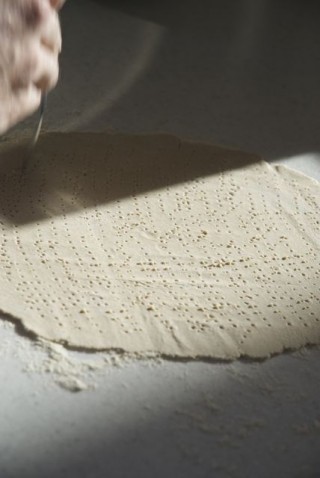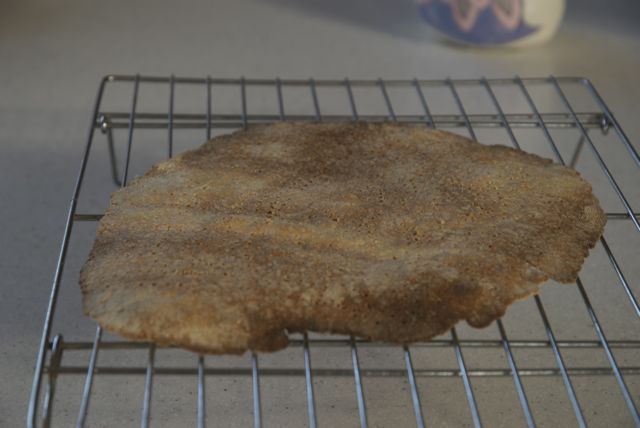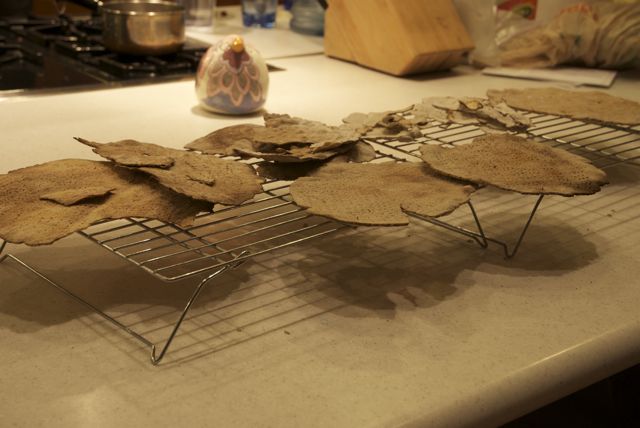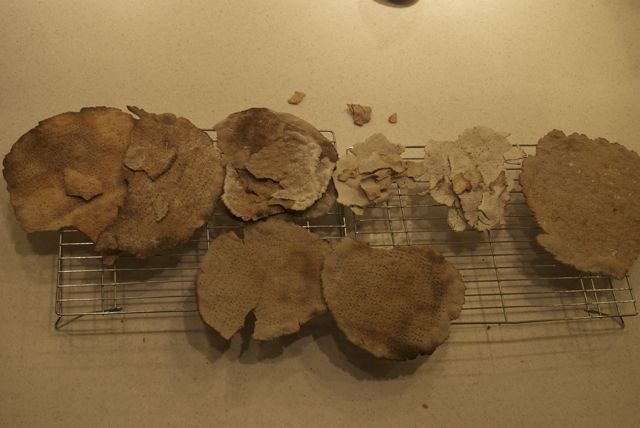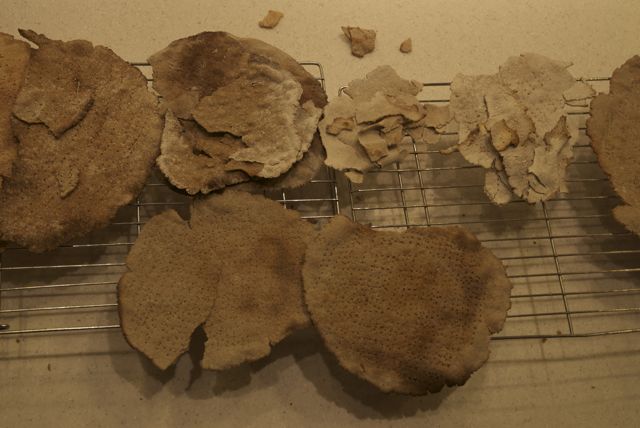You’ve read the prequel, now onto the main event.
Matzoh Making!
After I cleared the flour hurdles, I had one more rule to consider:
Matzoh must be made in under 18 minutes. According to the Talmud, the leavening process begins after water and flour have been in contact for 18 minutes, and leavened bread is exactly what we’re trying to avoid on Passover.
I knew that my mix would have to include some oat flour, much to my chagrin. In order to fulfill the commandment in the Torah, matzoh must be made from one of these five grains: wheat, spelt, rye, barley, and oat. Knowing oat flour’s penchant for dusty textures and its preference for the crumbly over the crisp, I decided to use it for only half of my flour blend. I had hoped this would mitigate its more unfortunate character flaws.
I was wrong. The first batch was 50% oat flour and 50% quinoa flour-it had an irritatingly sour taste. I obviously poured scorn onto the oat flour, blaming it for the poor taste and thoroughly un-crisp texture, but I was mistaken. Well, partially mistaken. There were, in fact, two villains in this culinary caper. As a firm believer in tasting all ingredients, I pinched some quinoa flour into my mouth and discovered the source of the unfortunate bitterness.
I apologized to the oat flour for my quick condemnation and scurried the quinoa flour away for another day(perhaps it would lend a good flavor to my sourdough…).
After round one, the flour blends become distinctly more complex. I found that there were several features of matzoh I was trying to mimic, and each time I conquered one, I lost another to the abyss. I wanted my matzoh to be easily rolled out, crisp and relatively neutral in taste. I also knew that what I’d be producing would have much more in common with shmura matzoh than with its angular, commercially produced brother we see on most grocery shelves. It would, of course, not be white.
The amount of oat flour in my blend began to drop as I realized its only redeeming quality was a name drop in the bible. Buckwheat stepped in when I wanted to use sorghum, providing some backbone and crunch to the cracker. Then, as I rounded the bend of blend #5, things got sticky. Literally. The dough was incredibly difficult to roll out, partially due to excess water, but mostly the fault of tapioca flour. I was getting nostalgic (a potential chemistry killer) and tried to lighten the color of the matzoh by adding in more tapioca flour.
And it was a mistake.
I liked the taste of the un-rollable cracker #5, but knew it was terribly impractical to release a recipe that was more mess than success. On a whim I began using potato flour, a staple in the “kosher for Passover” kitchen. What a joy it was to roll batch #6! It was springy and didn’t stick to the table or the rolling pin. I could roll it so very thinly without much trouble and then slide it into the oven without it splitting and tearing. A true joy.
And then it came out of the oven. Ugh.
I had certainly solved the rolling issue, but in the course of tackling that beast, I lost control of the flavor wagon. This new batch tasted distinctly of potato flour, not terribly unpleasant in and of itself, but far too un-neutral. It would simply stand out too much, everyone invited to dinner would wonder about its ingredients. To get the flavor under control without losing the supreme rollability of batch #6, I began incrementally cutting back the potato flour.
And then another though struck me(bluntly as they usually do)-what about using an additional potato product to improve the texture? My love affair with tapioca dashed to pieces, I felt no hesitation adding another starch into the blend (tapioca is a jealous lover, very absorbent in baking). I tossed some potato starch into my mix and rolled out batch #8. When it came out of the oven I knew I was on the right track. One more batch to finalize the proportions and I was finished!
Now, as you look through the recipe you will notice there are five different flours in this final flour blend. Do not distress! If you don’t already have them on hand, these are all ingredients you will use for other gluten free baking adventures. And trust me-I would not have needlessly made a complicated blend. If I could make matzoh that was easy to roll out, crisp and distinctly flavor neutral with only two flours, I would have. But I am chasing perfection (more dangerous than Chasing Amy), and that has led me to this point.
As for the baking, do it on a pizza stone and you are guaranteed the scorched flavor of traditional shmura matzoh. Spending only 4-5 minutes in the oven, the baking is the easiest part of this journey.
Stick around for the next installation of The Matzoh Diaries: Matzoh Balls!
No joke.
I really make them.
And so will you.
Free of Gluten, Dairy, Corn, Soy, Sugar, Salt, you name it, it’s not here.
- 4 tablespoons Buckwheat Flour
- 4 tablespoons Potato Starch
- 4 tablespoons Tapioca Flour
- 3 tablespoons Oat Flour
- 1 tablespoon Potato Flour
- 6 tablespoons Water
Get Busy
- Put a pizza stone in your oven and preheat everything to 550 degrees.
- In a large bowl whisk together all dry ingredients.
- Stir in the water. This will be a stiff dough that wants your hands, give it the love it kneads.
- Lightly flour your tabletop. Squeeze off a ball of dough roughly the size of a golf ball. Roll it out until it is very thin, but not torn (about 1/6 to 1/4 inch thick). Using a fork, prick it all over. Go ahead, make it holey. Set this aside and continue to prepare the balls of dough.
- When all the dough has been prepared, bring the unbaked matzoh to your oven and slide it onto the pizza stone.
- Bake the matzoh for 4-5 minutes, or until it is lightly toasted on top.
- Remove the crackers with tongs, they will be extremely hot. Set them on a rack to cool.
Prep. Time: 10 minutes
Baking Time: 4-5 minutes
Yield: ~4 large crackers

